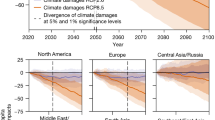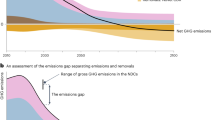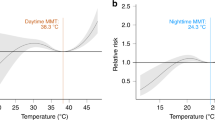Abstract
Biases in climate model simulations introduce biases in subsequent impact simulations. Therefore, bias correction methods are operationally used to post-process regional climate projections. However, many problems have been identified, and some researchers question the very basis of the approach. Here we demonstrate that a typical cross-validation is unable to identify improper use of bias correction. Several examples show the limited ability of bias correction to correct and to downscale variability, and demonstrate that bias correction can cause implausible climate change signals. Bias correction cannot overcome major model errors, and naive application might result in ill-informed adaptation decisions. We conclude with a list of recommendations and suggestions for future research to reduce, post-process, and cope with climate model biases.
This is a preview of subscription content, access via your institution
Access options
Access Nature and 54 other Nature Portfolio journals
Get Nature+, our best-value online-access subscription
$29.99 / 30 days
cancel any time
Subscribe to this journal
Receive 12 print issues and online access
$209.00 per year
only $17.42 per issue
Buy this article
- Purchase on Springer Link
- Instant access to full article PDF
Prices may be subject to local taxes which are calculated during checkout






Similar content being viewed by others
References
Hewitson, B. C., Daron, J., Crane, R. G., Zermoglio, M. F. & Jack, C. Interrogating empirical-statistical downscaling. Climatic Change 122, 539–554 (2014).
Adams, P. et al. Toward an Ethical Framework for Climate Services: A White Paper of the Climate Services Partnership Working Group on Climate Services Ethics (2015); http://www.climate-services.org/wp-content/uploads/2015/09/CS-Ethics-White-Paper-Oct-2015.pdf
Flato, G. et al. in Climate Change 2013: The Physical Science Basis (eds Stocker, T. F. et al.) 741–866 (IPCC, Cambridge Univ. Press, 2013).
Kotlarski, S. et al. Regional climate modelling on European scales: a joint standard evaluation of the EURO-CORDEX RCM ensemble. Geosci. Model. Dev. Discuss. 7, 217–293 (2014).
Maurer, E. P., Brekke, L., Pruitt, T. & Duffy, P.B. Fine-resolution climate projections enhance regional climate change impact studies. Eos 88, 504 (2007).
Li, H., Sheffield, J. & Wood, E. F. Bias correction of monthly precipitation and temperature fields from Intergovernmental Panel on Climate Change AR4 models using equidistant quantile matching. J. Geophys. Res. 115, D10101 (2010).
Dosio, A., Paruolo, P. & Rojas, R. Bias correction of the ENSEMBLES high resolution climate change projections for use by impact models: analysis of the climate change signal. J. Geophys. Res. 117, D17110 (2012).
Hagemann, S. et al. Impact of a statistical bias correction on the projected hydrological changes obtained from three GCMs and two hydrology models. J. Hydrometeorol. 12, 556–578 (2011).
Stoner, A. M. K., Hayhoe, K., Yang, X. & Wuebbles, D. J. An asynchronous regional regression model for statistical downscaling of daily climate variables. Int. J. Climatol. 33, 2473–2494 (2013).
Girvetz, E. H. et al. Making Climate Data Relevant to Decision Making: The Important Details of Spatial and Temporal Downscaling (The World Bank, 2013).
Hempel, S., Frieler, K., Warszawski, L., Schewe, J. & Piontek, F. A trend-preserving bias correction—the ISI-MIP approach. Earth Syst. Dyn. 4, 219–236 (2013).
Maurer, E. P. et al. An enhanced archive facilitating climate impact and adaptation analysis. Bull. Am. Meteorol. Soc. 95, 1011–1019 (2014).
CORDEX. Bias-adjusted RCM data (2016); http://www.cordex.org/index.php?option=com_content&view=articleid=275Itemid=785
Gangopadhyay, S., Pruitt, T., Brekke, L. & Raff, D. Hydrologic projections for the Western United States. Eos 92, 441–442 (2011).
Hagemann, S. et al. Climate change impact on available water resources obtained using multiple global climate and hydrology models. Earth Syst. Dynam. 4, 129–144 (2013).
Warszawski, L. et al. The Inter-Sectoral Impact Model Intercomparison Project (ISIMIP): Project framework. Proc. Natl Acad. Sci. USA 111, 3228–3232 (2014).
Cayan, D. et al. In Assessment of Climate Change in the Southwest United States: A Report Prepared for the National Climate Assessment 101–125 (Island Press, 2013).
Turn Down the Heat: Climate Extremes, Regional Impacts, and the Case for Resilience (World Bank, 2013).
Georgakakos, A. et al. In Climate Change Impacts in the United States: The Third National Climate Assessment 69–112 (US Global Change Research Program, 2014).
Climate Change Knowledge Portal (World Bank; accessed July 2017); http://sdwebx.worldbank.org/climateportal/
prepdata. Partnership for Resilience and Preparedness (PREP; accessed July 2017 ); http://www.prepdata.org
Maraun, D. et al. Precipitation downscaling under climate change. Recent developments to bridge the gap between dynamical models and the end user. Rev. Geophys. 48, RG3003 (2010).
Teutschbein, C. & Seibert, J. Bias correction of regional climate model simulations for hydrological climate-change impact studies: review and evaluation of different methods. J. Hydrol. 456, 12–29 (2012).
Piani, C., Haerter, J. O. & Coppola, E. Statistical bias correction for daily precipitation in regional climate models over Europe. Theor. Appl. Climatol. 99, 187–192 (2010).
Vannitsem, S. Bias correction and post-processing under climate change. Nonlin. Proc. Geophys. 18, 911–924 (2011).
Eden, J., Widmann, M., Grawe, D. & Rast, S. Skill, correction, and downscaling of GCM-simulated precipitation. J. Clim. 25, 3970–3984 (2012).
Maraun, D. Bias correction, quantile mapping and downscaling: revisiting the inflation issue. J. Clim. 26, 2137–2143 (2013).
Maraun, D. & Widmann, M. The representation of location by a regional climate model in complex terrain. Hydrol. Earth Syst. Sci. 19, 3449–3456 (2015).
Addor, N., Rohrer, M., Furrer, R. & Seibert, J. Propagation of biases in climate models from the synoptic to the regional scale: implications for bias adjustment. J. Geophys. Res. 121, 2075–2089 (2016).
Stocker, T. F., Dahe, Q., Plattner, G.-K. & Tignor, M. IPCC Workshop on Regional Climate Projections and their Use in Impacts and Risk Analysis Studies (2015); https://www.ipcc.ch/pdf/supporting-material/RPW_WorkshopReport.pdf
Ehret, U., Zehe, E., Wulfmeyer, V., Warrach-Sagi, K. & Liebert, J. Should we apply bias correction to global and regional climate model data? Hydrol. Earth Syst. Sci. 16, 3391–3404 (2012).
Haerter, J. O., Hagemann, S., Moseley, C. & Piani, C. Climate model bias correction and the role of timescales. Hydrol. Earth Syst. Sci. 15, 1065–1079 (2011).
Johnson, F. & Sharma, A. A nesting model for bias correction of variability at multiple time scales in general circulation model precipitation simulations. Wat. Resour. Res. 48, W01504 (2012).
Michelangeli, P.-A., Vrac, M. & Loukos, H. Probabilistic downscaling approaches: application to wind cumulative distribution functions. Geophys. Res. Lett. 36, L11708 (2009).
Piani, C. & Haerter, J. O. Two dimensional bias correction of temperature and precipitation copulas in climate models. Geophys. Res. Lett. 39, L20401 (2012).
Vrac, M. & Friederichs, P. Multivariate-intervariable, spatial, and temporal-bias correction. J. Clim. 28, 218–237 (2015).
Levy, A. A. L. et al. Can correcting feature location in simulated mean climate improve agreement on projected changes? Geophys. Res. Lett. 40, 354–358 (2013).
Barsugli, J. J. et al. The practitioner’s dilemma: How to assess the credibility of downscaled climate projections. Eos 94, 424–425 (2013).
Wang, C., Zhang, L., Lee, S.-K., Wu, L. & Mechoso, C. R. A global perspective on CMIP5 climate model biases. Nat. Clim. Change 4, 201–205 (2014).
Christensen, J. H., Boberg, F., Christensen, O. B. & Lucas-Picher, P. On the need for bias correction of regional climate change projections of temperature and precipitation. Geophys. Res. Lett. 35, L20709 (2008).
Buser, C. M., Künsch, H. R., Lüthi, D., Wild, M. & Schär, C. Bayesian multi-model projection of climate: bias assumptions and interannual variability. Clim. Dynam. 33, 849–868 (2009).
Maraun, D. Nonstationarities of regional climate model biases in European seasonal mean temperature and precipitation sums. Geophys. Res. Lett. 39, L06706 (2012).
Teutschbein, C. & Seibert, J. Is bias correction of regional climate model (RCM) simulations possible for non-stationary conditions? Hydrol. Earth Syst. Sci. 17, 5061–5077 (2013).
Johnson, F. & Sharma, A. Accounting for interannual variability: a comparison of options for water resources climate change impact assessments. Wat. Resour. Res. 47, W04508 (2011).
Berg, P., Feldmann, H. & Panitz, H.-J. Bias correction of high resolution regional climate model data. J. Hydrol. 448–449, 80–92 (2012).
Chen, C., Haerter, J. O., Hagemann, S. & Piani, C. On the contribution of statistical bias correction to the uncertainty in the projected hydrological cycle. Geophys. Res. Lett. 38, L20403 (2011).
Dosio, A. & Paruolo, P. Bias correction of the ENSEMBLES high resolution climate change projections for use by impact models: evaluation on the present climate. J. Geophys. Res. 116, D16106 (2011).
Themeßl, M. J., Gobiet, A. & Leuprecht, A. Empirical-statistical downscaling and error correction of daily precipitation from regional climate models. Int. J. Climatol. 31, 1530–1544 (2011).
Gudmundson, L., Bremnes, J. B., Haugen, J. E. & Engen-Skaugen, T. Technical Note: Downscaling RCM precipitation to the station scale using statistical transformations a comparison of methods. Hydrol. Earth Syst. Sci. 16, 3383–3390 (2012).
Rajczak, J., Kotlarski, S. & Schär, C. Does quantile mapping of simulated precipitation correct for biases in transition probabilities and spell lengths? J. Clim. 29, 1605–1615 (2016).
Masato, G., Hoskins, B. J. & Woollings, T. Winter and summer Northern Hemisphere blocking in CMIP5 models. J. Clim. 26, 7044–7059 (2013).
Woollings, T. Dynamical influences on European climate: an uncertain future. Phil. Trans. R. Soc. A 368, 3733–3756 (2010).
Zappa, G., Shaffrey, L. C. & Hodges, K. I. The ability of CMIP5 models to simulate North Atlantic extratropical cyclones. J. Clim. 26, 5379–5396 (2013).
Davini, P. et al. Climate SPHINX: evaluating the impact of resolution and stochastic physics parameterisations in the EC-Earth global climate model. Geosci. Model Dev. 10, 1383–1402 (2017).
Pithan, F., Shepherd, T. G., Zappa, G. & Sandu, I. Climate model biases in jet streams, blocking and storm tracks resulting from missing orographic drag. Geophys. Res. Lett. 43, 7231–7240 (2016).
van Niekerk, A., Scinocca, J. F. & Shepherd, T. G. The modulation of stationary waves, and their response to climate change, by parameterized orographic drag. J. Atmos. Sci. 74, 2557–2574 (2017).
Ashfaq, M., Skinner, C. B. & Diffenbaugh, N. S. Influence of SST biases on future climate change projections. Clim. Dynam. 36, 1303–1319 (2011).
Scaife, A. A. et al. Improved Atlantic winter blocking in a climate model. Geophys. Res. Lett. 38, L23703 (2011).
Keeley, S. P. E., Sutton, R. T. & Shaffrey, L. C. The impact of North Atlantic sea surface temperature errors on the simulation of North Atlantic European region climate. Q. J. R. Meteorol. Soc. 138, 1774–1783 (2012).
Shepherd, T. G. Atmospheric circulation as a source of uncertainty in climate change projections. Nat. Geosci. 7, 703–708 (2014).
Hall, A. Projecting regional change. Science 346, 1461–1462 (2014).
Colette, A., Vautard, R. & Vrac, M. Regional climate downscaling with prior statistical correction of the global climate forcing. Geophys. Res. Lett. 39, L13707 (2012).
Maurer, E. P. & Pierce, D. W. Bias correction can modify climate model simulated precipitation changes without adverse effect on the ensemble mean. Hydrol. Earth Syst. Sci. 18, 915–925 (2014).
Gobiet, A., Suklitsch, M. & Heinrich, G. The effect of empirical-statistical correction of intensity-dependent model errors on the temperature climate change signal. Hydrol. Earth Syst. Sci. 19, 4055–4066 (2015).
Pierce, D. W., Cayan, D. R., Maurer, E. P., Abatzoglou, J. T. & Hegewisch, K. C. Improved bias correction techniques for hydrological simulations of climate change. J. Hydrometeorol. 16, 2421–2442 (2015).
Switanek, M. B. et al. Scaled distribution mapping: a bias correction method that preserves raw climate model projected changes. Hydrol. Earth Syst. Sci. 21, 2649–2666 (2017).
Bellprat, O., Kotlarski, S., Lüthi, D. & Schär, C. Physical constraints for temperature biases in climate models. Geophys. Res. Lett. 40, 4042–4047 (2013).
Bellenger, H., Guilyardi, E., Leloup, J., Lengaigne, M. & Vialard, J. ENSO representation in climate models: from CMIP3 to CMIP5. Clim. Dynam. 42, 1999–2018 (2014).
Chen, L., Li, T. & Yu, Y. Causes of strengthening and weakening of ENSO amplitude under global warming in four CMIP5 models. J. Clim. 28, 3250–3274 (2015).
Collins, M. et al. Climate Change 2013: The Physical Science Basis (eds Stocker, T. F. et al.) 1029–1136 (IPCC, Cambridge Univ. Press, 2013).
Annamalai, H., Hafner, J., Sooraj, K. P. & Pillai, P. Global warming shifts the monsoon circulation, drying South Asia. J. Clim. 26, 2701–2718 (2013).
Roxy, M. K. et al. Drying of indian subcontinent by rapid indian ocean warming and a weakening land-sea thermal gradient. Nat. Commun. 6, 7423 (2015).
Willison, J., Robinson, W. A. & Lackmann, G. M. North atlantic storm-track sensitivity to warming increases with model resolution. J. Clim. 28, 4513–4524 (2015).
Hall, A., Qu, X. & Neelin, J. D. Improving predictions of summer climate change in the united states. Geophys. Res. Lett. 35, L01702 (2008).
Christensen, J. H. & Boberg, F. Temperature dependent climate projection deficiencies in CMIP5 models. Geophys. Res. Lett. 39, L24705 (2012).
Kendon, E. J. et al. Heavier summer downpours with climate change revealed by weather forecast resolution model. Nat. Clim. Change 4, 570–576 (2014).
Meredith, E. P., Maraun, D., Semenov, V. A. & Park, W. Evidence for added value of convection permitting models for studying changes in extreme precipitation. J. Geophys. Res. 120, 12500–12513 (2015).
Collins, M. et al. Quantifying future climate change. Nat. Clim. Change 2, 403–409 (2012).
Simpson, I. R., Seager, R., Ting, M. & Shaw, T. A. Causes of change in northern hemisphere winter meridional winds and regional hydroclimate. Nat. Clim. Change 6, 65–70 (2016).
Qu, X. & Hall, A. On the persistent spread in snow-albedo feedback. Clim. Dynam. 4, 69–81 (2014).
Dawson, A., Palmer, T. N. & Corti, S. Simulating regime structures in weather and climate prediction models. Geophys. Res. Lett. 39, L21805 (2012).
Liu, P. et al. An MJO simulated by the NICAM at 14- and 7-km resolutions. Mon. Weath. Rev. 137, 3254–3268 (2009).
Prein, A. F. et al. A review on regional convection-permitting climate modeling: demonstrations, prospects, and challenges. Rev. Geophys. 53, 323–361 (2015).
Volosciuk, C., Maraun, D., Vrac, M. & Widmann, M. A combined statistical bias correction and stochastic downscaling method for precipitation. Hydrol. Earth Syst. Sci. 21, 1693–1719 (2017).
Walton, D. B., Sun, F., Hall, A. & Capps, S. A hybrid dynamical–statistical downscaling technique. part i: Development and validation of the technique. J. Clim. 28, 4597–4617 (2015).
Maraun, D. et al. VALUE: a framework to validate downscaling approaches for climate change studies. Earth’s Future 3, 1–14 (2015).
Prudhomme, C., Wilby, R. L., Crooks, S., Kay, A. L. & Reynard, N. S. Scenario-neutral approach to climate change impact studies: application to flood risk. J. Hydrol. 390, 198–209 (2010).
Schär, C., Frei, C., Lüthi, D. & Davies, H. C. Surrogate climate-change scenarios for regional climate models. Geophys. Res. Lett. 23, 669–672 (1996).
Hazeleger, W. et al. Tales of future weather. Nat. Clim. Change 5, 107–113 (2015).
Klein Tank, A. M. G. et al. Daily dataset of 20th-century surface air temperature and precipitation series for the European Climate Assessment. Int. J. Climatol. 22, 1441–1453 (2002).
Gutiérrez, J. M., Cano, R., Cofiño, A. S. & Sordo, C. Analysis and downscaling multi-model seasonal forecasts in Peru using self-organizing maps. Tellus A 57, 435–447 (2005).
Maurer, E. P., Wood, A. W., Adam, J. C., Lettenmaier, D. P. & Nijssen, B. A long-term hydrologically-based data set of land surface fluxes and states for the conterminous United States. J. Clim. 15, 3237–3251 (2002).
van Vuuren, D. P. et al. The Representative Concentration Pathways: an overview. Climatic Change 109, 5–31 (2011).
Acknowledgements
Many of the ideas laid out in this paper have been developed during discussions within the EU COST Action ES1102 ‘VALUE’, in particular during the workshop ‘Global climate model biases: causes, consequences and correctability’ held at the Max Planck Institute for Meteorology, Hamburg, October 2014.
Author information
Authors and Affiliations
Contributions
The paper is a result of a workshop organized by D.M. and S.H. D.M. wrote the first draft of the manuscript with inputs from all authors. D.M., G.Z., J.M.G. and D.W. contributed analyses underlying the figures. All authors discussed the content of the manuscript.
Corresponding author
Ethics declarations
Competing interests
The authors declare no competing financial interests.
Rights and permissions
About this article
Cite this article
Maraun, D., Shepherd, T., Widmann, M. et al. Towards process-informed bias correction of climate change simulations. Nature Clim Change 7, 764–773 (2017). https://doi.org/10.1038/nclimate3418
Received:
Accepted:
Published:
Issue Date:
DOI: https://doi.org/10.1038/nclimate3418
This article is cited by
-
Drought Atlas of India, 1901–2020
Scientific Data (2024)
-
Future changes in the precipitation regime over the Arabian Peninsula with special emphasis on UAE: insights from NEX-GDDP CMIP6 model simulations
Scientific Reports (2024)
-
Uncertainties in measuring precipitation hinders precise evaluation of loss of diversity in biomes and ecotones
npj Climate and Atmospheric Science (2024)
-
An exhaustive investigation of changes in projected extreme precipitation indices and streamflow using CMIP6 climate models: A case study
Journal of Earth System Science (2024)
-
Bias Correction in CMIP6 Models Simulations and Projections for Brazil’s Climate Assessment
Earth Systems and Environment (2024)



